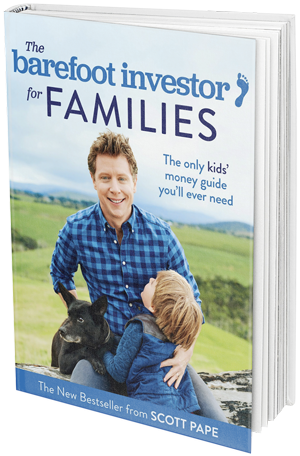Book Review: The Barefoot Investor for Families
Oct 21, 2018
Ever heard it said that we don’t receive any financial education in New Zealand?
Well, we pretty much still don’t BUT Australian Scott Pape, author of the new book The Barefoot Investor for Families is trying to change that. This is his second book and it is as readable as his first.
I’ve got two copies to give away, I’m donating a third to the Dunstan High School library (in the vain hope that some passing teen will read it and have their life changed forever) and for those who live close to me, I have kept a forth copy for myself and you are welcome to borrow it, just get in touch! FYI Scott has donated one to EVERY school in Australia!
I have given his first book The Barefoot Investor to a number of people and for pretty much all of them it proved to be a turning point in their financial lives. They made positive changes with how they handled money as a result of reading it. I think that once WE as adults become better with money then it’s natural that we want to enlighten our kids, grandkids, nieces and nephews so this book is a must read in my view because it guides you through the steps of how to do it WITHOUT annoying the hell out of the child.
For the secondary school teachers reading this blog, this is a book that you need to have in your school library for the kids whose parents are NEVER going to show them the way with money because they simply have no idea themselves. If I was a kid in school and I knew this book existed I would have read it! I searched for such a thing and never found it. In the perfect world, you work through this book as a family but we all know that is not possible for everyone and this book could just prove pivotal for some kid at your school. How cool would that be?
The book opens with the scene of you farewelling your 18-year-old from home as they leave to live independently for the first time and you ask yourself the question “Did I do enough to prepare them?”
His latest book focusses on kids and teenagers and he maps out a series of family dinners where each week, for ten weeks, you complete a task until you have completed The Barefoot Ten. At the end of which you will have equipped your children to really get the jump on financial independence where money is not a source of concern throughout their life.
He talks you through the following:
Before your child leaves home, they should have:
Opened a zero-fee, high-interest savings account
Bought and sold something second hand
Learned to cook at least two low-cost delicious, nutritious meals from scratch
Volunteered in their local community
Saved you at least $100 on your household bills
Promised to never, ever get a credit card
Got a part-time job from age 15
Earned at least one glowing reference from a boss
Opened up an ultra-low-cost, high-growth super fund
Set up a savings account for a home deposit
If you think this might be a dry money book, don’t worry it’s not, as Scott is not trying to create future economic boffins here for whom capitalism and earning money is their everything. That kid would be a right pain in the butt. Instead, he is trying to create great kids who know what a day’s work looks like, are confident that they know what to do with money and who contribute to both their family and to society and he wants to give you the tools to help your child get to that point.
By following his steps it helps us have a logical conversation to a sometimes hard crowd (kids and teenagers) and instead of dropping nuggets of wisdom to our kids that have absolutely no context like “Never get a credit card” he helps you explain to your family WHY and HOW you can avoid ever even needing one.
I really like how he enables adults to teach. Kids and teens are regularly doing things for the very first time and this book gives them the tools to cope with these new situations, like applying for their first job. I particularly like his guide for creating a resume, applying for work and having a job interview. This way you can send your child into a situation well prepared and confident you have set them up for success. Who doesn't want that for their kids?.
He stresses the importance of time - kids have time on their side and if they just do a few key things right from an early age they will become millionaires. It is kinda unavoidable when you look at the math and he uses some great examples to back this up. Like my favourite example that shows you the power of compound interest:
If at the age of 15 your teen invests $5,000 every year until the age of 25 and then never invests another cent, at 60 years old they will have $2,709,677. BUT if they don’t start putting $5,000 away until they turn 25 and they continue to put it away every single year until they turn 60 they will only have $1,645,197. A difference of over $1,000,000. Say what! (Page 202, make sure you check it out!)
I think that this is a book that you need to read from cover to cover first at which point you can decide at what age to start working through it with your kids. And it will also make you look at yourself and your own situation and ask if YOU are doing everything in an optimal way - if as a parent you are struggling with money then chances are your children will too but it's not hard to change the narrative. As I write this I can see that my own ten-year-old daughter has already started working her way through the steps (see some pics below), some she has completed and others we are building the foundations for now and I know that it’s going to take a lot of conversations over a long period of time. And I’m fine with that.
This book really comes into its own when your child hits those teenage years BUT you need to read it well before then so you can be sure you are setting up the groundwork first, you know your kids best and will know when you can introduce things to them. Prior to publishing, he had a number of families give his ten step process a trial run and throughout the book, they give their feedback on how it has worked for them which is great.
This book is written for an Australian market so when he mentions specific bank accounts and superannuation funds they are not relevant here, but you can still apply the principle of what he is on about and you CAN find the relevant funds here in New Zealand. Do not let it put you off, it just means you need to do a bit of homework yourself!
I’ve found our own workaround for my daughter by using:
Piggy banks at home for spending, saving and giving
Sub-account off my own bank account with TSB for longer-term saving until such time as she has her own accounts
Simplicity Growth for her KiwiSaver (where one day her employer will contribute and she will receive the member tax credit)
SmartShares (or you could use SuperLife or Sharesies) for her Index Fund (share) investing
Your child is at home with you for about 18 years, that is a decent stretch of time to teach them a whole heap of useful stuff. The Barefoot Investor view is that money should definitely be one of those things. Personally, I don’t mind that my daughter is not taught about money in school. Have you been in a classroom lately? My daughter is in a class of 34 and those places are crazy busy enough as it is without adding something else into the already packed curriculum. So instead of bemoaning that fact YOU and I have it well within our power to do something about it ourselves and this book will give a clear blueprint to do it. That way when they do leave home and head off to do their own thing you will feel confident in the fact that they ARE going to be OK and that you did a great job as a parent. In the words of Scott Pape “YOU GOT THIS!”
BOOK GIVEAWAY:
The Barefoot Investor for Families
The Barefoot Investor for Families BOOK GIVEAWAY was a great success and congratulations to our winners who won a copy of the book. Thank you to all my subscribers who entered.
If you want to read it now you can try your local library or you can purchase a copy via my link to PaperPlus.
Let me know what you think of the book!
Happy Saving!
Ruth
Here are just some of the things my 10 year old is doing: 1. This is her “Sharing” money box where each week she puts some of her pocket money. She gets to decide who she shares it with and recently it was ME when she gave me the money to buy myself a coffee. 2. This is the type of note I like to see on my desk! 3. Earlier this year she went around the neighbourhood selling bags of daffodil bulbs to raises money for a project she was working on. 4. This paper chain is a visual cue I use to show her how much she has invested. It takes a long time to add a link showing her that money is hard to make.








